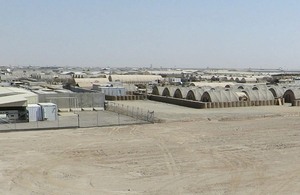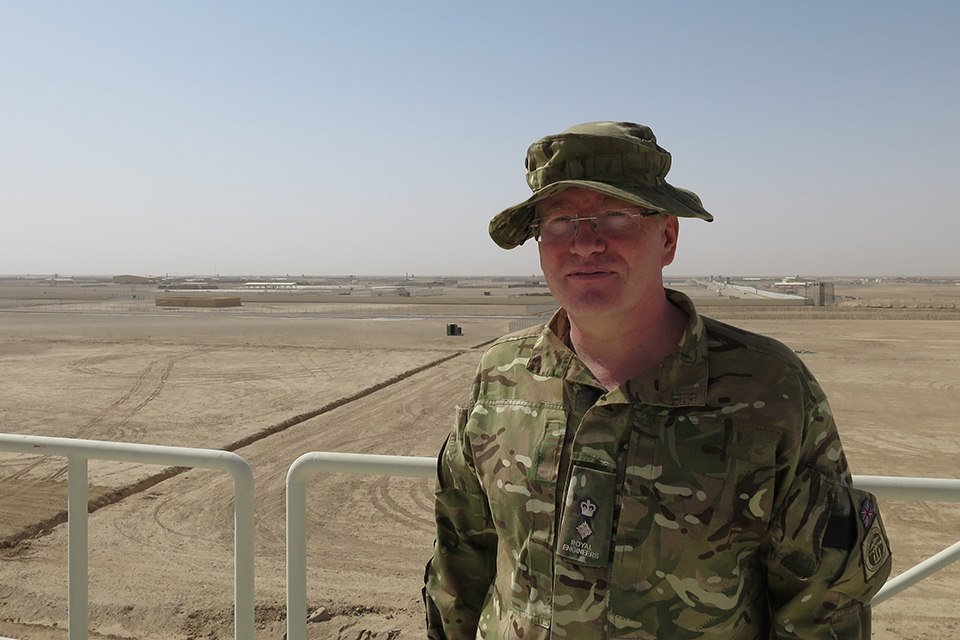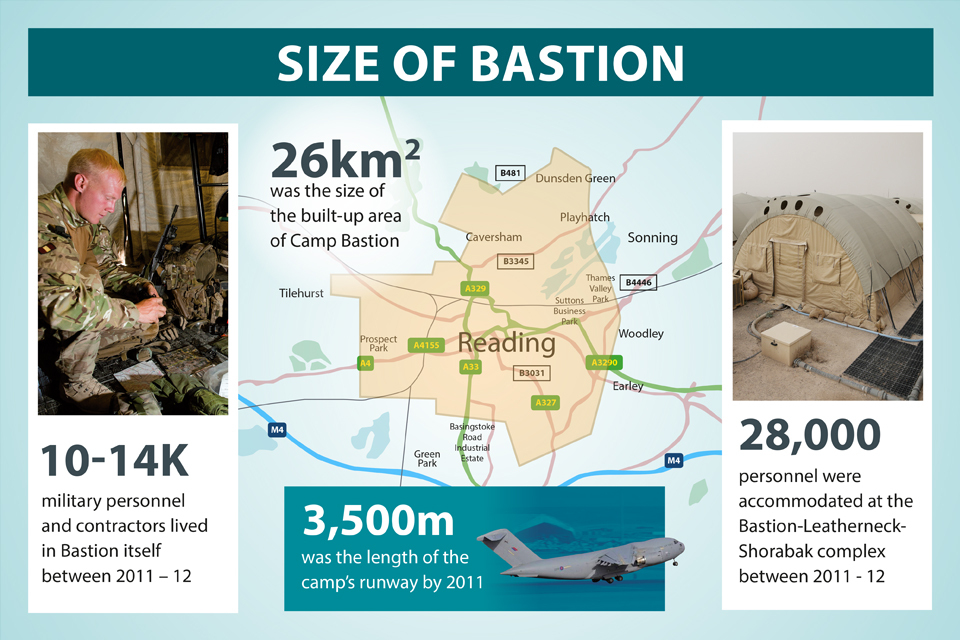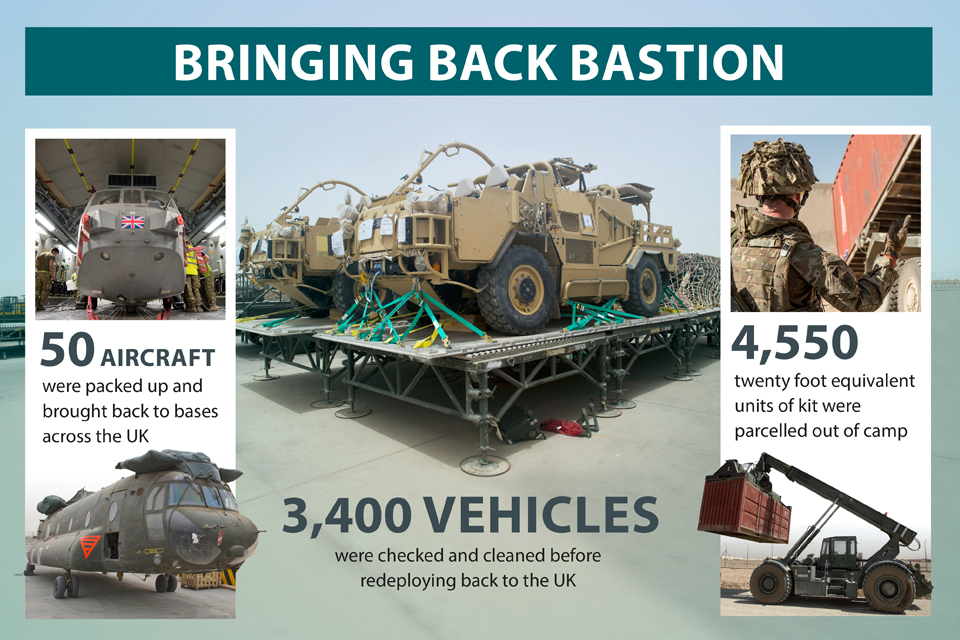Bye-bye Bastion
Building and packing up the largest operational UK military base to be built since the Second World War.

Camp Bastion during the drawdown [Picture: Emily Bird, Crown copyright]
Building Bastion
Camp Bastion was just a patch of sand with a few tents in 2005 and the thought of air conditioning was a distant dream. In 2006, construction began at the camp in order to support the changing role of UK operations in Afghanistan.
Designed by Royal Engineers and built by them using a team of military engineers and contractors.
By 2007, engineering construction of the runway and hospital was underway.
As operations in Afghanistan evolved, so did the camp. It developed almost organically and the camp grew to meet the needs of the troops.
It was a difficult task to fly and ship every single piece of equipment into the middle of a war zone, and in the middle of nowhere.
On top of that was the added challenge of sustaining it all - a challenge the team of skilled engineers and contractors rose to.

Senior Infrastructure Officer for the British Armed Forces in Afghanistan Lieutenant Colonel Laurence Quinn [Picture: Emily Bird, Crown copyright]
One man who was at the camp since its early days was Lieutenant Colonel Laurence Quinn. He said:
When I first arrived the runway wasn’t a runway. It was just a dirt strip outside the wire. It was a very different place.
As Senior Infrastructure Officer for the British Armed Forces in Afghanistan, and a chartered civil engineer, Lieutenant Colonel Quinn saw Bastion grow into the fortress it became.
Since December 2013, he had responsibility for packing the camp away so it was handed over to the Afghan National Army (ANA), and the airfield handed to the Afghan Civil Aviation Authority, in the best possible condition.
Lieutenant Colonel Quinn likens the camp in its heyday to ‘Aldershot with Gatwick stuck on the side’.
When the camp was at its peak (2011-2012), the Bastion-Leatherneck-Shorabak complex (the US and Afghan bases within the broader site) accommodated 28,000 personnel.

Size of Camp Bastion at its peak (2011-2012)
During this time, there were 600 fixed and rotary wing movements a day and newspapers reported it as being the fifth busiest UK operated airfield.
Camp Bastion had 3 huge dining facilities each capable of feeding around 7,000 diners.
It also had a Pizza Hut, KFC and even its own water bottling plant sucking up water from 300 feet below the Helmand desert, tapping into water that once fell as snow on the Hindu Kush mountain range.
It became so huge some newspapers compared its size to the size of Reading.
So, when it was decided that the camp would be handed over to the ANA at the end of Operation Herrick, how did they pack up Bastion, a whopping 26-square-kilometre military site?
Lieutenant Colonel Quinn explained:
Bastion had to be broken down into stages. We had to make sure that each stage throughout the drawdown and the final base itself were sustainable.
Even though Bastion was downsizing, the capabilities of the troops and the force protection of the camp couldn’t be compromised.
Lieutenant Colonel Quinn had the tricky task of balancing the objective of withdrawing without reducing the protection or the forces ability to do its job well.
Panoramic view of Camp Bastion with most of the camp packed away
After almost a decade of growth and use, checking every section of camp to collect the equipment and then deciding what to do with it was a huge task.
Overseeing this responsibility was Major Charlie Perkins the Theatre Logistics Group Adjutant.
She managed various departments that spent months sweeping through the areas where units once stood and collecting any left-over kit and everyday objects, like TVs, that had been accumulated.
Depending on the item and its condition, it was then decided whether it was redeployed back to the UK, gifted to the Afghans, sold, scrapped or recycled.
Major Perkins said:
It’s been a resource intensive task so getting everyone working flexibly was important.
We had to make sure we did our job on time and everyone’s played his or her part to make that happen. It’s been a massive effort.

Number of vehicles and equipment redeployed to the UK
Just as kit and equipment were flown and shipped in to Camp Bastion to build it, items that were redeployed to the UK were cleaned up and serviced before making its way by land, sea and air back home.
Folding up Bastion, right up to the very end and to the very last tent, was part of the intricate plan to make sure that it was left in the best possible condition as the UK Armed Forces closed Bastion’s doors for the final time.
Lieutenant Colonel Quinn concluded:
Camp Bastion is an incredible achievement for the whole of the Armed Forces and whilst we should be rightly proud of our efforts in counter-insurgency, we should also be proud of what we’ve done here.
It was the biggest base built since the Second World War to sustain operations in the face of potent insurgency. I, for one, am really proud of Camp Bastion.
Although, this is a goodbye to Camp Bastion, and the combative operation has now ended, there is still a role for the UK in Afghanistan.
A few hundred specialists and troops will remain in the country, mainly in Kabul, to continue to advise and mentor the Afghans in building a strong and sustainable security force.